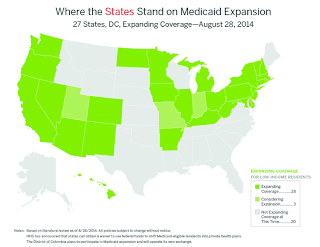Over the last year, one of the most frequently asked questions by people living with HIV/AIDS, public policy advocates, representatives from the health care and pharmaceutical industries and others, "What is the future of the AIDS Drug Assistance Program now that the Affordable Care Act is law?"
The answer is simple: It is too early to know for certain!
At first glance, data trends suggest that the passage of the ACA and its subsequent implementation has not slowed down client enrollment in ADAPs nationwide. According to the "National ADAP Monitoring Project - Annual Report," published by the National Alliance of State & Territorial AIDS Directors (NASTAD), client enrollment increased by over 15,000 between 2012 and 2013, or about an 8% increase. Last year, over 210,000 people living with HIV/AIDS were enrolled in ADAP. [1]
 |
| Chart: ADAP Client Enrollment, June 2003-2013 |
Not surprisingly, California has the largest statewide enrollment, with 22,702 clients, followed by New York with 17,193 clients, and Florida with 14,058 clients. Over sixty percent (97,142 clients) of the total clients served by ADAP were served by the top ten states -- including Texas, Puerto Rico, Illinois, North Carolina, Georgia, New Jersey and Pennsylvania). [2]
 |
| Chart: ADAP Clients Served and Top Ten States, by Clients Served, June 2013 |
One of the consistent themes heard at our 2014 Summit ("Intersection between ACA & ADAP") and 2014 Annual Conference ("Future of the AIDS Drug Assistance Program") was without concrete data, it is premature to make any assumptions about the Ryan White CARE Act, in general, and the AIDS Drug Assistance Programs, specifically. Another message that was fairly consistent, there is a significant disconnect between the advocacy work being done on Capitol Hill and the boots on the ground in local communities. It is also ill-advised to open-up the Ryan White law until we can better evaluate the intersection with the ACA, as well as the future of ADAP!
Clearly, ADAPs will remain a vital safety net for thousands of people living with HIV/AIDS next year and into the foreseeable future.
Probably one of the biggest unknown variables is the ongoing Medicaid expansion. "Spotty" is probably the best word to describe whether states are exercising the option to expand their Medicaid programs. Not surprisingly, some of the most resistance has come from southern states controlled by Republican Governors, or Republican State Legislatures.
 |
| Where the States Stand on Medicaid Expansion |
Another added variable is the recent Republican electoral wave. Whereas some pragmatic Republican legislators have moved beyond the "Repeal & Replace" chatter about Obamacare, there remain plenty of hard-liners who wish to do away with the law, or at least strip it of some major provisions. It is clearly too early to tell, but President Obama's veto pen is probably the law's best defense.
The ACA is also fueling new challenges for people living with HIV/AIDS; among them, emerging discriminatory practices. Monitoring these trends is an essential responsibility for all ADAP stakeholders. (Editor's Note: CLICK HERE to register for a free webinar, "Update on ACA Discriminatory Marketplace Exchange Practices")
One thing is abundantly clear in this conversation, and that is nothing is clear whatsoever. There are so many moving parts that could potentially impact the access to care for people living with HIV/AIDS.
_________
[1] NASTAD, National ADAP Monitoring Project Annual Report, February 2014, Chart 10, Page 13.
[2] NASTAD National ADAP Monitoring Project Annual Report - February 2014, Chart 12, Page 14.

No comments:
Post a Comment